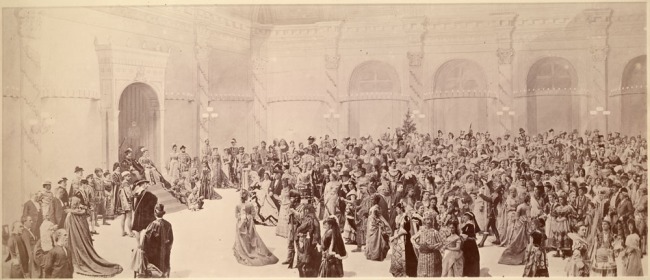
Fancy ball given by the Governor General Lord Dufferin at Rideau Hall on February 23, 1876. Credit: William James Topley / Library and Archives Canada / C-006865
Receiving an invitation to one of the Governor General’s fancy dress balls was once deemed a great honour. A fancy dress ball was a private costumed event that grew over the course of the nineteenth century after a social shift at the end of the previous century had made masquerades and parties seem immoral. Popular ideas for costumes at these lavish events included characters from literature; Shakespearean characters; characters from nursery rhymes and fairy tales; and characters from exotic lands (these costumes were sometimes collected or acquired from other countries).
The first major fancy dress ball in Canada was hosted by the Earl and Lady of Dufferin on February 23rd, 1876. The event was widely reported all over North America and Europe, and it became the paradigm of all subsequent fancy dress balls held in Canada. Descriptions of the guests’ costumes were quite detailed in newspapers that covered the event; acting as substitutes for visual documents, such as photographs, which were not yet used to accompany newspaper articles. However, there are many surviving photographs, both in the form of glass plate negatives and prints, which illustrate what the guests wore to this prestigious event. William James Topley photographed the Dufferin family and their guests in costume throughout the months following the ball with the hope that he would benefit financially and increase his clientele in Ottawa. After he had taken over three hundred individual portraits, he decided to create a composite photograph. This composite photograph was constructed by carefully cutting out individual subjects, pasting them onto a painting of the Rideau Hall ballroom, and then re-photographing the entire scene to create his finished product.
The composite photograph was very popular among photographers before the advent of cameras that allowed for shorter exposure times. Group photographs were problematic due to longer exposure times and slower emulsion speeds; it wasn’t uncommon for an individual to be moving during the exposure, or to be concealed behind another person in front of them. The composite photograph was introduced as a means of avoiding these kinds of issues. Montréal photographer William Notman often created impressive composite photographs (for example, see the first composite image that he created of the Victoria Rink in Montréal in 1870), and Topley likely learned this technique from Notman while he was working as his apprentice.
The original negative of this composite image has been lost, but Library and Archives Canada still possesses a small version that was deposited for copyright purposes. In this composite image, one can make out the portraits of Lord and Lady Dufferin, who are seated well above their guests on an elevated platform, and their three children near the base. They are appropriately costumed as the royal family of King James V of Scotland. One can also make out William Campbell, Lord Dufferin’s private secretary, who came costumed as a “Court Jester,” sitting in a child-like pose at the very base of the platform. There is clear social hierarchy that has been constructed by the photographer and his staff within this composite image – your eye is drawn almost immediately to the photograph’s focal point: the Dufferin family.
For a more in-depth look at fancy dress balls in Canada and more photographs taken by Topley of the hosts and their guests, please see Cynthia Cooper’s Magnificent Entertainments: Fancy Dress Balls of Canada’s Governors General, 1876-1898. Andrew Rodger also discusses this particular composite photograph on an online exhibition created by Library and Archives Canada titled William James Topley: Reflections on a Capital Photographer (information under the tab “The Studio” then “Composite Photographs”). You can also search for digitized images of the photographs taken by Topley on the Library and Archives Canada database.

Our society’s fascination with “dressing-up” in costume has not diminished over time, but has merely changed form. Halloween is immensely popular among children and adults alike; we love to assume, at least temporarily, another identity by changing our clothes. Also, various forms of sexual seduction and fetishes usually involve costuming. One still hears of contemporary dress balls, mainly among the rich and powerful, but I wonder why they are not more popular today.